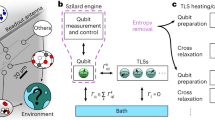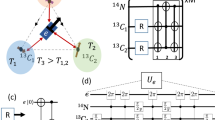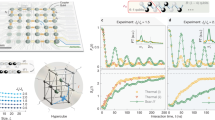Abstract
The counter-intuitive properties of quantum mechanics have the potential to revolutionize information processing by enabling the development of efficient algorithms with no known classical counterparts1,2. Harnessing this power requires the development of a set of building blocks3, one of which is a method to initialize the set of quantum bits (qubits) to a known state. Additionally, fresh ancillary qubits must be available during the course of computation to achieve fault tolerance4,5,6,7. In any physical system used to implement quantum computation, one must therefore be able to selectively and dynamically remove entropy from the part of the system that is to be mapped to qubits. One such method is an ‘open-system’ cooling protocol in which a subset of qubits can be brought into contact with an external system of large heat capacity. Theoretical efforts8,9,10 have led to an implementation-independent cooling procedure, namely heat-bath algorithmic cooling. These efforts have culminated with the proposal of an optimal algorithm, the partner-pairing algorithm, which was used to compute the physical limits of heat-bath algorithmic cooling11. Here we report the experimental realization of multi-step cooling of a quantum system via heat-bath algorithmic cooling. The experiment was carried out using nuclear magnetic resonance of a solid-state ensemble three-qubit system. We demonstrate the repeated repolarization of a particular qubit to an effective spin-bath temperature, and alternating logical operations within the three-qubit subspace to ultimately cool a second qubit below this temperature. Demonstration of the control necessary for these operations represents an important step forward in the manipulation of solid-state nuclear magnetic resonance qubits.
This is a preview of subscription content, access via your institution
Access options
Subscribe to this journal
Receive 51 print issues and online access
$199.00 per year
only $3.90 per issue
Buy this article
- Purchase on Springer Link
- Instant access to full article PDF
Prices may be subject to local taxes which are calculated during checkout



Similar content being viewed by others
References
Nielsen, M. A. & Chuang, I. L. Quantum Computation and Quantum Information (Cambridge Univ. Press, Cambridge, 2000)
Everitt, H., Havel, T. F. & Cory, D. G. (eds) Experimental aspects of quantum computing. Quant. Inform. Process. 3(1–5; special issue), 1–308 (2004).
DiVincenzo, D. P. The physical implementation of quantum computation. Fortschr. Phys. 48, 771–793 (2000)
Knill, E., Laflamme, R. & Zurek, W. H. Resilient quantum computation. Science 279, 342–345 (1998)
Kitaev, A. Y. in Quantum Communication and Computing and Measurement (eds Holevo, A. S., Hirota, O. & Caves, C. M.) 181–188 (Plenum, New York, 1997)
Aharonov, D. & Ben-Or, M. in Proc. 29th Annual ACM Symp. on Theory of Computing (eds Leighton, F. T. & Shor, P.) 176–188 (ACM Press, New York, 1997)
Preskill, J. Reliable quantum computers. Proc. R. Soc. Lond. A 454, 385–410 (1998)
Schulman, L. J. & Vazirani, U. V. in Proc. 31st Annual ACM Symp. on Theory of Computing (eds Vitter, J. S., Larmore, L. & Leighton, T.) 322–329 (ACM Press, New York, 1999)
Boykin, P. O., Mor, T., Roychowdhury, V., Vatan, F. & Vrijen, R. Algorithmic cooling and scalable NMR quantum computers. Proc. Natl Acad. Sci. USA 99, 3388–3393 (2002)
Fernandez, J. M., Lloyd, S., Mor, T. & Roychowdhury, V. Algorithmic cooling of spins: a practicable method for increasing polarization. Int. J. Quant. Inform. 2, 461–467 (2004)
Schulman, L. J., Mor, T. & Weinstein, Y. Physical limits of heat-bath algorithmic cooling. Phys. Rev. Lett. 94, 120501 (2005)
Knill, E., Laflamme, R., Martinez, R. & Tseng, C.-H. An algorithmic benchmark for quantum information processing. Nature 404, 368–370 (2000)
Gershenfeld, N. & Chuang, I. L. Bulk spin-resonance quantum computation. Science 275, 350–356 (1997)
Cory, D. G., Price, M. D. & Havel, T. F. Nuclear magnetic resonance spectroscopy: An experimentally accessible paradigm for quantum computing. Physica D 120, 82–101 (1998)
Cory, D. G. et al. NMR based quantum information processing: achievements and prospects. Fortschr. Phys. 48, 875–907 (2000)
Leskowitz, G. M., Ghaderi, N., Olsen, R. A. & Mueller, L. J. Three-qubit nuclear magnetic resonance quantum information processing with a single-crystal solid. J. Chem. Phys. 119, 1643–1649 (2003)
Abragam, A. & Goldman, M. Nuclear Magnetism: Order and Disorder 339–393 (Clarendon, Oxford, 1982)
Fortunato, E. M. et al. Design of strongly modulating pulses to implement precise effective Hamiltonians for quantum information processing. J. Chem. Phys. 116, 7599–7606 (2002)
Jagannathan, N. R., Rajan, S. S. & Subramanian, E. Refinement of the crystal structure of malonic acid, C3H4O4 . J. Chem. Crystallogr. 24, 75–78 (1994)
Cory, D. G., Miller, J. B. & Garroway, A. N. Time-suspension multiple-pulse sequences: applications to solid-state imaging. J. Magn. Res. 90, 205–213 (1990)
Haeberlen, U. High Resolution NMR in Solids: Selective Averaging Suppl. 1, Advances in Magnetic Resonance 64–69 (Academic, New York, 1976)
Moussa, O. On Heat-bath Algorithmic Cooling and its Implementation in Solid-state NMR. Page 20, M.Sc. thesis, Univ. Waterloo (2005); available at http://www.iqc.ca/~omoussa/work/thesis/
Acknowledgements
We thank D. G. Cory, T. F. Havel and C. Ramanathan for discussions and use of NMR simulation code; W. P. Power, M. J. Ditty and N. J. Taylor for facility use and experimental assistance; CIAR, ARDA and NSERC for support. O.M. acknowledges the Ontario Ministry of Training, Colleges and Universities for support.
Author information
Authors and Affiliations
Corresponding author
Ethics declarations
Competing interests
Reprints and permissions information is available at npg.nature.com/reprintsandpermissions. The authors declare no competing financial interests.
Rights and permissions
About this article
Cite this article
Baugh, J., Moussa, O., Ryan, C. et al. Experimental implementation of heat-bath algorithmic cooling using solid-state nuclear magnetic resonance. Nature 438, 470–473 (2005). https://doi.org/10.1038/nature04272
Received:
Accepted:
Issue Date:
DOI: https://doi.org/10.1038/nature04272
This article is cited by
-
Adiabatic Spin Dynamics by Chirped Microwave Pulses Based on AWG-ESR
Applied Magnetic Resonance (2023)
-
Hyperthermia increases HSP production in human PDMCs by stimulating ROS formation, p38 MAPK and Akt signaling, and increasing HSF1 activity
Stem Cell Research & Therapy (2022)
-
The nonequilibrium cost of accurate information processing
Nature Communications (2022)
-
Molecular Optimization for Nuclear Spin State Control via a Single Electron Spin Qubit by Optimal Microwave Pulses: Quantum Control of Molecular Spin Qubits
Applied Magnetic Resonance (2022)
-
Cyclic cooling of quantum systems at the saturation limit
npj Quantum Information (2021)
Comments
By submitting a comment you agree to abide by our Terms and Community Guidelines. If you find something abusive or that does not comply with our terms or guidelines please flag it as inappropriate.



